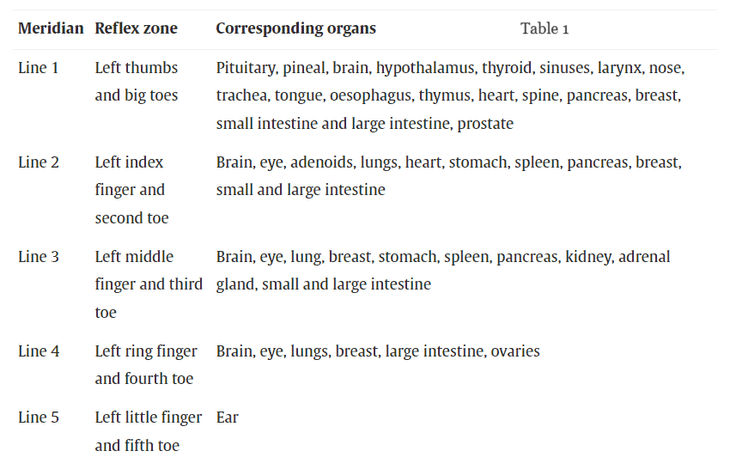Reflexology Zones

Understanding Reflexology Zones
Reflexology is based on zone theory, which postulates the existence of vertical pathways of energy running through the body.
The 10 longitudinal zones
Zones serve as a means of connecting different parts of the body through a set of guidelines or markers.
These guidelines consist of ten equal vertical zones that extend from the top of the body down to the feet.
Each toe on the soles of our feet belongs to a particular zone.
The body is partitioned into ten longitudinal zones with a straightforward numbering sequence.
Each zone travels through the body, separates into one of the arms, continues straight down through the body, and then goes into the respective leg until it lines up with a specific toe.

Each foot has five zones, with the big toe as zone one through to the little toe, which is zone five. The fingers correspond to the same zones as the toes.
The left foot corresponds to the left side of the body, while the right foot corresponds to the right side.
For instance, the liver is on the right side of the body, and its reflex area is located on the right foot.

These zones span the body in vertical sections, and by working on the feet, you can stimulate corresponding areas throughout the body.
The principle behind reflexology is that energy flows between all parts of the body within these zones.
By applying pressure to these areas, you can access and stimulate the corresponding body parts.
Pressure applied to a specific zone on the foot can relieve pain in the corresponding body part.
Each foot corresponds to organs and structures on its respective side of the body.
Meridians in the body connect each zone to its corresponding organ or body part.
Any obstruction along these lines can disrupt the energy flow, potentially causing malfunction.
Unblocking the energy channel within a zone allows the body to function in harmony.
Understanding zone theory is crucial for treating and preventing illness, as diseases tend to follow these zones.
The 3 transverse lines
In addition to the 10 longitudinal zones, 3 transverse lines divide the body horizontally.
These lines are known as the shoulder line, the diaphragm line, and the pelvic line.
They divide the foot into 4 sections: the head and neck area, the chest area, the abdominal area, and the pelvic area.

1. Head and Neck Area: The shoulder line, located just below the toes, corresponds to the brain, eyes, ears, nose, and throat. Stimulating this line helps relieve pain and promote healing.
2. Chest Area: The diaphragm line, located at the lower borders of the balls of the foot, corresponds to the diaphragm muscle and respiratory function. Pressure on this line can reduce stress and improve breathing.
3. Abdominal Area: The waistline, found in the center of the foot, represents the stomach and intestines. Pressure here can aid digestion and relieve stomach issues.
4. Pelvic Area: The pelvic line, located at the base of the toes, corresponds to the sacrum and lower back. Stimulating this line can relieve lower back pain and reduce tension in the hips.
Balancing the zones
During a reflexology session, the practitioner will examine the feet for areas of sensitivity, which may indicate an imbalance in the corresponding body zone.
For example, conjunctivitis in the right eye may suggest an energy imbalance in the right kidney and surrounding structures.
The reflexes on the feet are particularly effective as they are situated at the ends of the zones and are more sensitive than other body parts.
This sensitivity allows the practitioner to pinpoint areas of imbalance and apply targeted pressure.

Pressure applied to a specific zone on the foot can relieve pain in the corresponding body part.
Each foot corresponds to organs and structures on its respective side of the body.
References
Figure 1
Zone Therapy By William H. Fitzgerald, Edwin F. Bowers, George S. White (1994).
Figure 2
Zone Therapy By William H. Fitzgerald, Edwin F. Bowers, George S. White (1994).
Table 1
J. Minckler - Energy Balancing Zone Therapy (2014).
Table 2
J. Minckler - Energy Balancing Zone Therapy (2014).
Figure 3
J Tradit Complement Med. 2015 Oct; 5(4) - Revisiting reflexology: Concept, evidence, current practice, and practitioner training.

